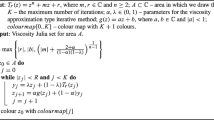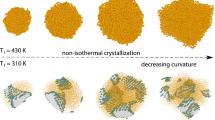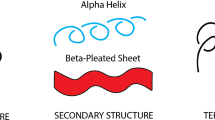Abstract
We consider single ring polymers which are confined on a plane but maintain a fixed three-dimensional knotted topology. The equilibrium statistics of such systems is studied on the basis of a model on square lattice in which the configurations are represented by N-step polygons with a number of self-intersections restricted to the minimum compatible with the topology. This allows to define the size, s, of the flat knots and to study their localization properties. Due to the presence of both excluded volume and attractive interactions, the model undergoes a theta transition. Accurate Monte Carlo results show that, while in the high temperature swollen regime both prime and composite knot components are localized (〈s〉 N ∼N t, with t=0), in the low temperature, compact phase they are fully delocalized (t=1). Right at the theta transition weak localization prevails (t=0.44±0.02). Part of the results can be interpreted by taking into account a dominance of figure eight shapes for the coarse grained knotted polymer configurations, and by applying the scaling theory of polymer networks of fixed topology. In particular t=3/7 can be conjectured as an exact exponent characterizing the weak knot localization at the theta point.
Similar content being viewed by others
REFERENCES
S. Y. Shaw and J. C. Wang, Knotting of a DNA chain during ring closure, Science 260:533–536 (1993).
V. L. Rybenkov, N. R. Cozzarelli, and A. Vologodskii, Probability of DNA knotting and the effective diameter of the DNA double helix, Proc. Nat. Acad. Sci. USA 90:5307–11 (1993).
S. A. Wasserman and N. R. Cozzarelli, Biochemical topology: applications to DNA recombination and replication, Science 232:951–960 (1986).
A. D. Bates and A. Maxwell, DNA Topology (IRL Press, 1993).
F. B. Dean, A. Stasiak, T. Koller, and N. R. Cozzarelli, Duplex DNA knots produced by Escherichia coli topoisomerase I, J. Biol. Chem. 260:4795–4983 (1985).
C. D. Lima, J. C. Wang, and A. Mondragon, Three-dimensional structure of the 67K N-terminal fragment of E. coli DNA topoisomerase I, Nature 367:138–146 (1994).
S. A. Wasserman and N. R. Cozzarelli, Supercoiled DNA-directed knotting by T4 topoisomerase, J. Biol. Chem. 266, 20567–20573 (1991).
M. A. Krasnow, A. Stasiak, S. J. Spengler, F. Dean, T. Koller, and N. R. Cozzarelli, Determination of the absolute handedness of knots and catenanes of DNA, Nature 304:559–560 (1983).
N. J. Crisona, et al., Processive Recombination by Wild-Type Gin and an Enhancer-Independent Mutant: insight into the Mechanisms of Recombination Selectivity and Strand exchange, J. Mol. Biol. 243:437–457 (1994).
S. A. Wasserman, J. M. Dungan, and N. R. Cozzarelli, Discovery of a predicted DNA knot substantiates a model for site-specific recombination, Science 229:171–174 (1985).
A. Stasiak, V. Katritch, J. Bednar, D. Michoud, and J. Dubochet, Electrophoretic mobility of DNA knots, Nature 384:122(1996).
H. L. Frisch and E. Wasserman, Chemical Topology, J. Am. Chem. Soc. 83:3789–3795 (1968).
M. Delbruck, Mathematical Problems in the Biological Sciences (AMS, Providence, RI, 1962), p. 55.
D. W. Sumners and S. G. Whittington, Knots in self-avoiding walks, J. Phys. A: Math. Gen. 21:1689–1694 (1988).
N. Pippenger, Knots in random walks, Disc. Appl. Math. 25:273–278 (1989).
K. Koniaris and M. Muthukumar, Knottedness in ring polymers, Phys. Rev. Lett. 66:2211–2214 (1991).
P.-G. de Gennes, Tight knots, Macromolecules 17:703–704 (1984).
T. Strick, J. F. Allemand, V. Croquette, and D. Bensimon, The manipulation of single biomolecules, Physics Today 54:46–51 (2001).
S. F. Edwards, Statistical mechanics with topological constraints: I, Proc. Phys. Soc. 91:513–519 (1967).
A. V. Vologodskii, A. V. Lukashin, M. D. Frank-Kamenetskii, and V. V. Anshelevich, The knot probability in statistical mechanics of polymer chains, Sov. Phys. JETP 39:1059–1063 (1974).
M. D. Frank-Kamenetskii, A. V. Lukashin, and A. V. Vologodskii, Statistical mechanics and topology of polymer chains, Nature 258:398–402 (1975).
J. P. J. Michels and F. W. Wiegel, On the topology of a polymer ring, Proc. Roy. Soc. A 403:269–284 (1986).
S. F. Edwards, Statistical mechanics with topological constraints: II, J. Phys. A 1:15–28 (1968).
T. Deguchi and K. Tsurusaki, Topology of closed random polygons, J. Phys. Soc. Japan 62:1411–1414 (1993).
E. Orlandini, E. J. Janse van Rensburg, M. C. Tesi, D. W. Sumners, and S. G. Whittington, Topology and Geometry of Biopolymers (IMA Volumes in Mathematics and its Applications), 82:21–37 (1996).
A. Yu. Grosberg and S. Nechaev, Algebraic invariants of knots and disordered Potts model, J. Phys. A 25:4659–4672 (1992).
A. Yu. Grosberg, Critical exponents for random knots, Phys. Rev. Lett. 85:3858–3861 (2000).
A. Yu. Grosberg, Self-avoiding knots, preprint, cond-mat/0207427 (2002).
E. J. Janse van Rensburg and S. G. Whittington, The knot probability in lattice polygons, J. Phys. A 23:3573–3590 (1990).
E. J. Janse van Rensburg and S. G. Whittington, The dimensions of knotted polygons, J. Phys. A 24:3935–3948 (1991).
E. Orlandini, M. C. Tesi, E. J. Janse van Rensburg, and S. G. Whittington, Asymptotics of knotted lattice polygons, J. Phys. A 31:5953–5967 (1998).
S. R. Quake, Topological effects of knots in polymers, Phys. Rev. Lett. 73:3317–3320 (1994).
E. Orlandini, M. C. Tesi, E. J. Janse van Rensburg, and S. G. Whittington, Entropic exponents of lattice polygons with specified knot type, J. Phys. A 29:L299-L303 (1996).
B. Maier and J. O. Rädler, Conformation and Self-Diffusion of Single DNA Molecules Confined in Two Dimensions, Phys. Rev. Lett. 82:1911–1914 (1999).
E. Ben-Naim, Z. A. Daya, P. Vorobieff, and R. E. Ecke, Knots and random walks in vibrated granular chains, Phys. Rev. Lett. 86:1411–1416 (2001).
M. B. Hastings, Z. A. Daya, E. Ben-Naim, and R. E. Ecke, Entropic tightening of vibrated chains, Phys. Rev. E 66:R25102-R25105 (2002).
K. Murasugi, Knot theory and its applications (Birkhäuser, Boston, 1996).
E. Guitter and E. Orlandini, Monte Carlo results for projected self-avoiding polygons: a two-dimensional model for knotted polymers, J. Phys. A 32:1359–1385 (1999).
R. Metzler, A. Hanke, P. G. Dommersnes, Y. Kantor, and M. Kardar, Equilibrium shapes of flat knots, Phys. Rev. Lett. 88:188101(2002).
B. Duplantier, Statistical mechanics of polymer networks of any topology, J. Stat. Phys. 54:581–680 (1989).
K. Ohno and K. Binder, Theory of star polymers and general polymer networks in bulk and semi-infinite good solvents, J. Phys. (Paris) 49:1329–1352 (1988).
Y. Kafri, D. Mukamel, and L. Peliti, Why is the DNA denaturation transition first order?, Phys. Rev. Lett. 85:4988–4991 (2000).
V. Katrich, W. K. Olson, A. Vologodskii, J. Dubochet, and A. Stasiak, Tightness of random knotting, Phys. Rev. E 61:5545–5549 (2000).
O. Farago, Y. Kantor, and M. Kardar, Pulling knotted polymers, Europhys. Lett. 60:53–59 (2002).
C. Vanderzande, Lattice models of polymers (Cambridge University Press, 1998).
F. Takusagawa and K. Kamitori, A real knot in protein, Am. Chem. Soc. 118:8945–8946 (1996).
W. R. Taylor, A deeply knotted protein structure and how it might fold, Nature 406:916–919 (2000).
V. S. Pande and D. S. Rokhsar, Is the molten globule a third phase of proteins?, Proc. Natl. Acad. Sci. USA 95:1490–1494 (1998).
P. G. Dommersnes, Y. Kantor, and M. Kardar, Knots in charged polymers, Phys. Rev. E 66:031802(2002).
M. Baiesi, E. Carlon, and A. L. Stella, Scaling in DNA unzipping models: denaturated loops and end segments as branches of a block copolymer network, Phys. Rev. E 66:021804(2002).
E. Orlandini, A. L. Stella, and C. Vanderzande, The polymer theta-point as a knot delocalization transition, cond-mat/0211259 (2002); E. Orlandini, A. L. Stella, and C. Vanderzande, The polymer theta-point as a knot delocalization transitionPhys. Rev. E 68:031804(2003).
B. Nienhuis, Exact critical point and critical exponents of O(n) models in two dimensions, Phys. Rev. Lett. 49:1062–1065 (1982).
M. C. Tesi, E. J. Janse van Rensburg, E. Orlandini, and S. G. Whittington, Monte Carlo study of the interacting self-avoiding walk model, J. Stat. Phys. 82:155–181 (1996).
E. Orlandini, Monte Carlo study of polymer systems by multiple Markov Chain method, IMA Proc. Work. 102:33–57 (1996).
B. Duplantier and H. Saleur, Exact tricritical exponents for polymers at the Θ-point in two dimensions, Phys. Rev. Lett. 59:539–542 (1987).
F. Seno and A. L. Stella, θ point of a linear polymer in 2 dimensions: a renormalisation group analysis of Monte Carlo enumerations, J. Phys. 49:739–748 (1988).
H.-P. Hsu and P. Grassberger, Collapsed 2-dimensional polymers on a cylinder, J. Phys. A 35:L759-L766 (2002).
L. Schäfer, C. von Ferber, U. Lehr, and B. Duplantier, Renormalization of polymer networks and stars, Nucl. Phys. B 374:473–495 (1992).
B. Duplantier and H. Saleur, Exact critical properties of two-dimensional dense self-avoiding walks, Nucl. Phys. B 290:291–326 (1987).
E. J. Janse van Rensburg, D. W. Sumners, E. Wassermann, and S. G. Whittington, Entanglement complexity of self-avoiding walks, J. Phys. A 25:6557–6566 (1992).
Author information
Authors and Affiliations
Rights and permissions
About this article
Cite this article
Orlandini, E., Stella, A.L. & vanderzande, C. Loose, Flat Knots in Collapsed Polymers. Journal of Statistical Physics 115, 681–700 (2004). https://doi.org/10.1023/B:JOSS.0000019820.70798.ed
Issue Date:
DOI: https://doi.org/10.1023/B:JOSS.0000019820.70798.ed




